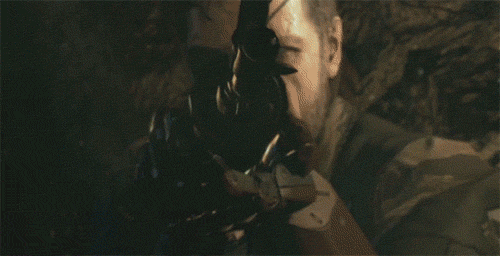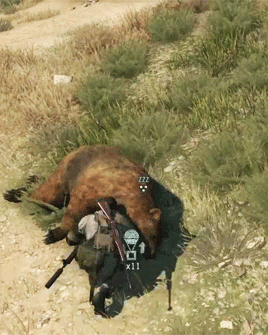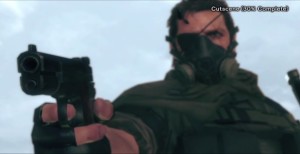The year was 1998 and I just so happened to be standing in an actual brick & mortar video store (man I miss those) trying to figure out what video game would tide me over the weekend. Most of everything on the shelf designated for “Playstation” games had already been played by yours truly or just weren’t of any interest to me. Then I saw one particular game’s cover. Bright red in color, the title almost screamed out, “You must play me, today!” I picked up the display game case to read, “Metal Gear Solid: Tactical Espionage Action”.
Ironically enough, I assumed this game would be perfect for something my dad and I could play together (even if it was a one-player game) simply because he was (and still is) into espionage style movies and TV shows. So why wouldn’t he love a game inspired by the genre. After renting the game, taking it home and putting the disc in my original Playstation, I was thrust into the lore of a brave new world. Having not played the NES or MSX “Metal Gear” games, I had no idea what I was in store for when it came to story lineage or wacky characters (and one incredible intro theme).
My dad never got the hang of the game and left it to me and me alone. My aunt Cicero would be kind enough to purchase “MGS” for me a month later, and I would spend the next several months playing through the game’s most rigorous and memorable moments. I was hooked and an official “Metal Gear Solid” fan. That wouldn’t change for me as I picked up (through rentals and purchases) every numbered “Metal Gear Solid” game Konami offered; patiently awaiting the next one after completing the previous iteration. Now, almost twenty years after my first time playing a piece of the franchise, I embark on “Metal Gear Solid’s” potential final journey with “Metal Gear Solid V: The Phantom Pain”. After much controversy between Konami and the series’ creator Hideo Kojima, I hoped that the final product wouldn’t be marred by the disputes.
Did I Complete “Metal Gear Solid V: The Phantom Pain”
“Metal Gear Solid V: The Phantom Pain” (or “MGS V”/“TPP”) follows the events of “Ground Zeroes” – a prologue game specifically designed to introduce the “TPP’s” world, characters and gameplay style to console/PC owners who didn’t play the “Playstation Portable” designed “Metal Gear Solid: Peace Walker”. Nine years after the events of “Ground Zeroes”, “Venom”/Punished Snake (or “Ahab”, or “Boss, or “Big Boss”) awakens from a coma and is joined by allies both new and old to create a military faction called “Diamond Dogs” in hopes of not only becoming a legitimate army, but also finding the person or people responsible for destroying his old unit and leaving him with a giant piece of metal sticking out his head.
The first hour or so is very “Metal Gear Solid-esque” complete with in-game cinematics, linear paths and moments you would only expect to see in a “Hollywood” film. But unlike “V’s” numbered predecessors, the game takes a sharp left after the initial hour and opens up the world for the player to make their own story through customization and mission pacing. Rather than being forced to take a linear path that is convenient to the story, handlers of Snake enter areas located in both central Afghanistan and the Angola-Zaire region of Africa to complete missions both important (simply called “Missions”) and detached from the story (“Side Ops”). The player is tasked with not only completing missions to help him/her succeed, but also build up the game’s “central hub”, “Mother Base”.
Though the game asks for more action than story than most are used to when playing a “MGS”, my main focus coming in was the story. The franchise’s lore and characters have always been incredibly intriguing and I was solely interested in seeing how the series would conclude while tying up loose ends (and maybe even creating a few more for speculation’s sake). I witnessed all three available “endings” placed in the game while going through Side Ops, building up Mother Base, recruiting soldiers and finding Easter Eggs. In my ninety-plus hours of playing (with around thirty occurring during “Chapter 2” and subtracting the time I left the game running so weapons would develop) I’ve completed all of my goals, yet still want to play some more (even if it means doing the same Side Ops missions to test out my latest customized weapon).
Did “Metal Gear Solid V: The Phantom Pain” Live Up to the Hype?
As noted above, “MGS V” takes less from its numbered brethren than a game designed from a portable system (and eventually ported to the Playstation 3 and Xbox 360). No better example is the world itself. “TPP” features a “sandbox”-like environment where the player isn’t usually stuck in a building or on the figurative rails that was a “Metal Gear Solid” trademark. While the game’s mission structure is still rooted in, “Go here, do that, get out,” the ability to decide how you go about the mission is mostly up to the player at all times. Want to be stealthy? Use the cover of darkness by doing the mission at night while wearing a “Sneaking Suit”. Like the action-adventure possibilities featuring a drawn-out shootout? With the right weaponry and Snake’s “Battle Dress” (it’s not actually a “dress”), you can pick off enemy after enemy in grand fashion. How about taking one of the four fully functional and actually helpful AI companions (or “Buddy Support”) on the mission to get you there faster, scope out enemies, and even take out potential adversaries before they even know what’s coming.
With each main/story mission comes a rating that goes up to “S-Rank” depending how fast and effective you are on the field (and the rating can be helped by how many hidden objectives you complete during the mission). Though simple, it adds a replay-ability factor not seen in any numbered “MGS” games before. Very few open world games like this actually goes out of its way to “tell” the player, “Do it your way,” without adding, “…but it would’ve probably worked out better this way.”
With “TPP” featuring the first real open world in the numbered series of “Metal Gear Solid” games comes the needed additions of dynamic time and weather. Day and night cycles last as one would expect – even in nature and not in real time. Added to the player’s ability to see the sun set and rise during one session, Snake can bear witness to Mother Nature’s power. The plains of Africa will witness rain showers and thunderstorms that can cause animals and people alike to scurry. The blistering Sun will see enemies take water and smoke breaks under the nearest tent. And the unpredictable sandstorms of Afghanistan (my personal favorite) can blind anyone not prepared – leaving them vulnerable to sneak attacks. You wouldn’t believe how many times I’ve been pinned down when a plan goes awry, only to have a random sandstorm kick up enough dust to shield my escape.
But what about the way Snake handles and the game’s core mechanics? For those who had the ability to play “Ground Zeroes”, one wouldn’t be surprised as everything found in that game from a gameplay perspective is indicative of what to expect from “TPP”. Leaning toward a more action-adventure approach, “The Phantom Pain” emphasizes stealth, but doesn’t punish the player if he/she decides to go against the series’ grain. One of the best examples of “TPP’s” wanting to help the player succeed even if stealth fails is the addition of “Reflex Mode” – an ability that allows time to slow down when Snake is spotted by an enemy and gives the player a few seconds to drop the potential alerter before everything goes downhill. While some “MGS” purists condemn “Reflex Mode” for hindering the “true” “Metal Gear” experience, it does help players avoid an entire mission failure simply because they didn’t spot one lone soldier walking out of sight. Plus, “Reflex Mode” can be turned off at any time (as can marking enemies – another “MGS” numbered first) – so what’s there to complain about?
There are more additions to the core gameplay to make “TPP” the most dynamic “Metal Gear Solid” game possible. Players can call in air support to take Snake out of a sticky situation or bombard the mounting oppression with rockets. Picked the wrong weapon for the job while preparing for the mission? Call in a supply drop and switch items in thirty seconds flat. The player can also switch out Buddies (who gain abilities depending on how much the player uses them in battle) at any time during the mission – once again potentially helping stop a FUBAR situation from unfolding due to the quick actions of AI enemies who will scour the area, use flares to illuminate the darkest nights and pick you off like shooting fish in a barrel if you’re not prepared.
“Metal Gear Solid V: The Phantom Pain” doesn’t just ask the payer to be a smart decision maker on the battlefield, the game wants you to structure Mother Base – the home of Diamond Dogs. As players make their way through the game, they are given the ability to Fulton extract items and people that are needed to build the most fearsome militia imaginable. Using high power binoculars, players are able to identify enemy’s special traits and abilities before knocking them out and transporting them to Mother Base with the touch of a button. The individuals and items attained through Fulton extractions become critical in fully experiencing what “TPP” has to offer. With materials and GMP (the game’s equivalent of currency), the player is able to expand Mother Base; giving room for more soldiers to develop weapons and gear faster, heal wounded soldiers who have been sent into off-screen “Combat Deployments” to gather resources, recruit other would-be Diamond Dogs, and defend the player’s personal fort from online attacks by other players from around the world through the game’s “Forward Operating Bases” (or “FOB” campaigns that actually help the single player campaign by giving the player a chance to steal soldiers and resources from other players from around the world). There’s also an animal preserve!
Depending on the skills of soldiers taken in, players are given the opportunity to craft more weapons than one could ever need for a game like this. These “special” recruits can play a critical role in the gameplay experience if the player chooses to go out of his/her way to attain them. I, for example, played a few Side Ops missions to ensure I had a “Suppressor Specialist” who could turn my tranquilizer rifle into a weapon that could take down an entire base without me getting spotted once. The customization options concerning weapons, gear, vehicles and even the Buddies are so in-depth and fun that it’s hard to believe how we “MGS” gamers got along without them for so long.
There’s also “Metal Gear Online” – which wasn’t released until a month after the game graced store shelves. As expected, “MGO” is a competitive multiplayer experience that allows players to team up and play “Metal Gear Solid” versions of Team Deathmatch, Capture the Flag and a mixture of the two emphasizing stealth. The player has the opportunity to create his/her own character to play as (you can use the avatar made during the opening hour of the game) one of three classes (each class focusing on one particular skill be it stealth, long range combat or heavy weapons & explosives). I’m not the biggest multiplayer gamer in the world, but found myself highly entertained with trying to survive while getting revenge stealth kills. Most importantly I was incredibly happy how easy it was to find a session and had no connection or slowdown problems seen in lesser online experiences. Unfortunately, only console players are able to play “MGO” right now, as the PC version won’t be released until January 2016.
As much as I praise “TPP”, the game isn’t perfect. If you haven’t noticed yet, nothing about the story was mentioned in the “positive” section of this review. Now, don’t think that means the story is terrible. Actually, the plot presented is rather strong. But it’s the way everything is presented that hurts “The Phantom Pain’s” overall story. Rather than stick with the typical narrative style of past “Metal Gear Solid” games, “The Phantom Pain” throws short cutscenes at the player before and after certain missions; leaving the rest of the narrative attached to cassette tapes. That’s right, you have to listen to a bunch of cassette tapes to gain a full appreciation for the plot. Most of the recordings are short (around three minutes in length), but later tapes can reach the double-digit mark in time.
Since this game is based on stealth, listening to the tapes during missions is pretty much a death sentence – meaning players will either be sitting in a helicopter or hanging around Mother Base playing tape after tape to fully grasp what is occurring in this game. That’s a lot of wasted time that could be used to actually play the game. And that’s not mentioning attempts at tackling such profound topics like children being forced into becoming soldiers, parent-offspring relationships and even rape fall incredibly short of their lofty narrative goals; or lacking memorable antagonists and having confusing allies (with Quiet really being one of the few characters not named “Snake” to actually have a true character arc in this “TPP” vacuum).
Then there’s the “Xenogears – Disc 2” problem. For those who don’t know – “Xenogears” was a game that came out around the same time as “Metal Gear Solid”. “Xenogears’” second disc changed the way the plot was showcased (sacrificing a lot of the gameplay in the process); giving off an incomplete feel that made many believe budget problems hindered “Xenogears’” full development. “TPP” suffers from the same problems as “Xenogears” with obvious content cut out of the story due to time constraints and the aforementioned problems between producers and creators. There’s even a cut fourth ending to the game that was supposed to be the 51st mission and would’ve answered one of the biggest plot holes created in “Chapter 2” – though one glaring problem in the “Metal Gear” lore is solved by the game’s “true” ending (all the while proving to be a “Thank You” message from Kojima to everyone who has supported the series). It’s so unfortunate a game of this magnitude featuring the potential final plot ties in the “Metal Gear” universe came out unfinished.
Probably the biggest error with the story isn’t the narrative being abridged, but the plot affecting progress. Late in “Chapter 1”, something critical to the story occurs that actually hinders the player’s progress in building Mother Base. If a player doesn’t go out of their way spoil the next few main missions (and an important plot point), he/she is left wondering how to stop this terrible moment from continuing. This problem plays out again in “Chapter 2”, but in quicker fashion that actually adds a great emotional moment to the game that has far too few of those incredible memorable instances compared to previous “Metal Gear Solid” offerings. If there’s one thing that I hate in any video game it’s being punished for progressing and attempting to play the game as its intended.
Though missions both big and small are mostly fun and enjoyable they are rarely unique once you make through the first ten or so hours. The lack of imaginative crafting when it comes to mission structure is the proof that either Kojima and crew were running short on ideas, or Konami didn’t give them the time needed to add some variety (or both). This creative gameplay problem is seen in full during “Chapter 2” where old missions are reused with added stipulations like an inability to have Buddies or failing the mission if Snake is spotted. There are some meaningful “Chapter 2” main missions and Side Ops (with some of those missions tied to story progression only becoming available after playing random and/or important Side Ops), but those missions fail to truly be anything other than time wasters.
With a lacking group of major antagonists, “TPP” also doesn’t feature memorable boss battles in the same vein as the fourth wall-breaking confrontation with Psycho Mantis in “Metal Gear Solid” or the sniper duel against “The End” in “MGS 3”. There are boss battles in the game, but few and far between and struggle to leave a lasting impression (even if the boss just gives up).
There are a few minor technical problems I’ve experienced during my time with the game including Snake’s problems with climbing rocks (the slipperiest rocks ever) and enemies spawning randomly from out of nowhere; difficulty spikes and finicky AI that ranges from competent to blind & deaf. The world isn’t as open and brimming with life as it appears with visible walls in the form of insurmountable mountains, humans existence only being found at outposts, and animals either running in small packs or not showing up for minutes on end even in the jungle. “Metal Gear Online” is dependent on a leveling system similar to “Call of Duty’s” “Prestige” system; causing players who don’t play religiously to work from behind and maybe even hinder their team. Then there’s the option of spending real money to increase a player’s “FOB” base – continuing the trend of microtransactions seen in games nowadays – not to mention Konami offering “FOB Insurance”. The game’s menu responding slowly when connected to the server. And most of those impressive moments seen in the pre-launch trailers are pretty much the entirety of epic “Metal Gear Solid” style cut scenes.
But those nitpicky “lowlights” rarely hinder the tightly refined gameplay and makes the game any less fun. It’s a lacking of certain traits that made previous “Metal Gear Solid” games great – memorable plot, characters, missions and boss battles – that also makes “Metal Gear Solid V: The Phantom Pain” feel like less the potential fitting end of a franchise rooted in delivering something extraordinary from a gameplay and storytelling standpoint.
Should You Play “Metal Gear Solid V: The Phantom Pain”?
Very few times in my life as a gamer have I had such differing opinions for one game. Actually playing “TPP”, from completing missions to building Mother Base, I’ve had nothing short of a fantastic, once-in-a-video-game-generation moment that I would hope everyone gets a chance to experience. On the opposite end of the spectrum sits the dissatisfied “Metal Gear Solid” fan in me who expected to be captivated by the story, compelled to hate or love a majority of the characters, and participate in digitized battles unlike anything I’d ever played – even when comparing it to previous iterations – but didn’t get what usually makes a “MGS” game unique.
For all of the negatives and disappointments attached to some of the characteristics long associated with the series, I still enjoyed “TPP” very much – and there is a lot of stuff I didn’t write about to avoid spoiling the game. Is it the greatest “Metal Gear Solid” experience ever? An argument can be made both in favor and against “Metal Gear Solid V: The Phantom Pain’s” place as the franchise’s masterpiece. But what can’t be denied is level of freedom offered to the player makes this one of the most accessible “Metal Gear” games of all time (come for and forget about the story, stay for the immaculate gameplay); high levels of innovation and customization; mostly intelligent AI; a suggestion for player excellence while attempting (and sadly failing short) of providing the same in return. “Metal Gear Solid V: The Phantom Pain” deserves to be played by every gamer who has the opportunity even if long-time fans would consider it the most polished, yet incomplete game (from a plot and mission variety perspective) in the franchise’s history. But don’t hype yourself up too much believing the bevy of perfect ratings handed down by people who haven’t put in the time to experience a majority of what “Metal Gear Solid V: The Phantom Pain” has and doesn’t have to offer. Now if you’ll excuse me – I have to save some random game creator.








